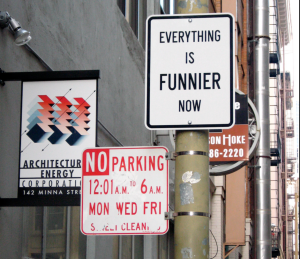
Disclaimer: Satterwhite doesn’t include much information about this project on his website. I attended a lecture he gave at Bard college, and this is from memory.
“Model It” is a performance in which Satterwhite dances in front of various storefronts to songs that his mother wrote. His performance is extraverted and swanky – a puzzling counterpoint to his mother’s incoherent, rambling music. It is an intensely personal work, emblematic of an ongoing creative dialogue between Satterwhite and his mother.
More here…

“Time/bank” is a currency created by the founders of the e-flux journal, Julieta Aranda and Anton Vidokle. Drawing influence from existing time banks, “Time/bank” proposes time as a unit of economic exchange, by way of “Hour Notes” (one is shown above). Interestingly, 2009 also saw the introduction of the Bitcoin, the open source cryptocurrency. Since Time/bank relies on fixed measures of time, it is both straightforward and stable, in opposition to today’s opaque and volatile cryptocurrencies.
More here…

“Occupy the Cloud” takes the form of three banners in front of a brutalist office building in central London. On each banner is a symbol, from left to right: the lightning bolt of the international squatters’ movement, the @ symbol (acquired by MoMA in 2010) and the Cloud symbol. The banal corporate aesthetic of the banners belies the polemical tone of the three symbols read sequentially. Taken together, they suggest that the Cloud is a prime site for political intervention. The installation is timely and ominous in the wake of the 2013 NSA revelations.
More here…

Anthony Discenza is an artist based in Oakland, California. Since late 1990s, he has been focusing on the the omnipresence of mainstream media. For Minna Street Sign Project, which the artist described as his”ongoing semi-guerilla street sign project”, he has been manipulating the public by using what they experience in there everyday life. Read more.
The CutUp Collective is an East-London based street art group that rips down billboard ads, cuts them into rectangular pieces and reposts them in such a way as to create an image completely different from the original. In doing so, the Collective subverts advertising (in a technique called subvertising) to call attention to the effects of consumerism and corporate image production in the city.
More here.
Comments Off on “CutUp Film” by CutUp Collective (2005)
Joshua Allen Harris is a street artist and a photographer based in USA. He became famous with his “The Inflatables” project. For this project he gathered plastic trash bags around New York City, shaped them in some animal forms, placed them on subway grates, and the gusts from the trains were strong enough to inflate his creatures. Read more.

CV Dazzle is a series of looks that prevents current facial recognition software from identifying the wearer’s face. In an age where Facebook uses your family album as machine learning data sets, this provides a sense of privacy and security against automated eyes. Read More
“L.A.S.E.R. Tag” combines a beefy projector and a high-powered laser to create gigantic and ephemeral tags. Used to aid Tibetan protesters in 2008, L.A.S.E.R. tag provides a large-scale platform for people to voice their opinions. Read More

“Anonymity” is a wearable that allows those who don it to preemptively disagree to the disclosure of their identity. Mimicking censor bars traditionally found in film and television, this piece acts as a real version by thwarting CCTV and other forms of surveillance. Read More
A self-proclaimed 100 year old online secret society, IDPW is a Japanese group that responds to the increasing homogenization of the internet through a series of web-themed parties. The Internet Black Market is a reaction to the increasing controlled platforms of commerce on the net. A variety of goods were sold, including an “IRL Re-tweet” (a guy who shouts your message), and stones with their scanned 3D data.





